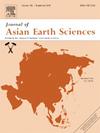巴基斯坦南部Bela蛇绿岩斜长花岗岩的锆石U-Pb年代学和地球化学:对海洋斜长花岗岩岩石成因的启示
IF 2.4
3区 地球科学
Q2 GEOSCIENCES, MULTIDISCIPLINARY
引用次数: 0
摘要
贝拉蛇绿岩位于巴基斯坦南部的印度板块西缘,在其地壳剖面上发育一套侵入斜长花岗岩(钠长花岗岩、钠长花岗岩和绿长花岗岩)。本文通过锆石U-Pb年代学、原位Lu-Hf和Sr-Nd同位素、综合地球化学分析来约束这些岩石的成因和构造意义。锆石U-Pb年代学测得结晶年龄约为65 Ma, εNd(t)值为3.9 ~ 6.9,εHf(t)值为12.9 ~ 24.0,与洋壳衰竭有关。稀土元素(REE)和多微量元素模式以及各种微量元素共变证实了斜长花岗岩是在部分熔融作用下形成的。贝拉斜长花岗岩的TiO2和Nb含量较低,LREE富集程度较轻,放射性成因(87Sr/86Sr)i值表明,这些岩石可能是洋壳扩张过程中剪切带内辉长岩(洋三层)部分熔融形成的。我们认为贝拉斜长花岗岩是晚白垩世至早古近纪新特提斯洋岩石圈在印度和欧亚板块之间初始俯冲过程中弧前地壳深熔的产物。本文章由计算机程序翻译,如有差异,请以英文原文为准。

Zircon U–Pb geochronology and geochemistry of plagiogranites from Bela Ophiolite, Southern Pakistan: implications for the petrogenesis of oceanic plagiogranite
The Bela Ophiolite, located along the western margin of the Indian Plate in southern Pakistan, hosts a suite of intrusive plagiogranites (albitites, albite granites, and epidote granites) within its crustal section. In this study, we present zircon U–Pb geochronology, in situ Lu–Hf and Sr–Nd isotopes, and comprehensive geochemical analyses to constrain the origin and tectonic significance of these rocks. Zircon U–Pb geochronology yielded crystallization ages of ca. 65 Ma, with εNd(t) values (3.9–6.9) and εHf(t) values varying from 12.9 to 24.0, implying a genetic relationship with the depleted oceanic crust. Rare earth elements (REE) and multi-trace element patterns, as well as various trace-element covariations, confirm that the plagiogranites formed in response to partial melting. The low TiO2 and Nb contents, slight LREE enrichment, and radiogenic (87Sr/86Sr)i values of the Bela plagiogranites indicate that these rocks were likely derived from the partial melting of gabbros (oceanic layer 3) within a shear zone during the process of oceanic crust spreading. We interpret the Bela plagiogranites as products of forearc crustal anatexis during the initial subduction of Neo-Tethyan oceanic lithosphere between the Indian and Eurasian plates during the Late Cretaceous to Early Paleogene.
求助全文
通过发布文献求助,成功后即可免费获取论文全文。
去求助
来源期刊

Journal of Asian Earth Sciences
地学-地球科学综合
CiteScore
5.90
自引率
10.00%
发文量
324
审稿时长
71 days
期刊介绍:
Journal of Asian Earth Sciences has an open access mirror journal Journal of Asian Earth Sciences: X, sharing the same aims and scope, editorial team, submission system and rigorous peer review.
The Journal of Asian Earth Sciences is an international interdisciplinary journal devoted to all aspects of research related to the solid Earth Sciences of Asia. The Journal publishes high quality, peer-reviewed scientific papers on the regional geology, tectonics, geochemistry and geophysics of Asia. It will be devoted primarily to research papers but short communications relating to new developments of broad interest, reviews and book reviews will also be included. Papers must have international appeal and should present work of more than local significance.
The scope includes deep processes of the Asian continent and its adjacent oceans; seismology and earthquakes; orogeny, magmatism, metamorphism and volcanism; growth, deformation and destruction of the Asian crust; crust-mantle interaction; evolution of life (early life, biostratigraphy, biogeography and mass-extinction); fluids, fluxes and reservoirs of mineral and energy resources; surface processes (weathering, erosion, transport and deposition of sediments) and resulting geomorphology; and the response of the Earth to global climate change as viewed within the Asian continent and surrounding oceans.
 求助内容:
求助内容: 应助结果提醒方式:
应助结果提醒方式:


